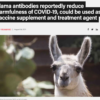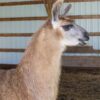Product Codes: 688710-688720-688730
SUMMARY
Transfusions of plasma are needed to increase serum immunoglobulins, total protein and albumin in crias that are deficient from lack of passive transfer. Blood transfusions should be given with care; immune responses can be similar to that of transplantation of a solid organ. Plasma should be administered slowly with the recipient observed for adverse reactions such as urticaria, fever, vomiting or anaphylaxis.1
Principle
Plasma transfusions are routinely done to prevent septicemia in new born crias that have a failure of passive transfer, a major determinant of cria mortality.2 Therapeutic benefits come from immunoglobulins, complement, albumin, fibronectin, clotting factors, antithrombin III as well as many other proteins and electrolytes. A marker protein indicating the amount of transfusion occurring is immunoglobulin G (IgG).
Reagents
Plasma is collected from immunized adult male llamas. A completely closed collection system is used without added preservatives. This product is frozen after collection and not pasteurized. Animals are immunized on a regular schedule with clostridium perfringens type C-Escherichia Coli Bacterin- toxiod, clostridium chauvoei-septicum-haemolyticum-novyi-tetani-perfringens types C and D bacterin-toxoid, equine rhinopneumonitis killed virus, bovine rota-coronavirus modified live virus, J-5 E. coli bacterin, IMRAD 3 rabies vaccine a killed virus made by Rhone Merieux, inactivated cultures of leptospira canicola, grippotyphosa, hardjo ichterohaemorrhagiae and pomona. Animals are checked for eperythrozoon, leptospirosis, anaplasmosis, brucellosis, tuberculosis and blue tongue by an outside laboratory. IgG titer ranges from 1500 mg/dl to 3000 mg/dl. Blood is collected in plasmaphoresis bleeding units with 60 mls of anticoagulant containing 2.4g Sodium Citrate (hydrous) for 600 mls of blood. Plasma is separated by centrifugation and transferred to transfer packs of 300mls plus or minus 15%.
Procedure:
A. Materials provided:
- Plasma
B. Materials required:
Blood transfer set. Administer through a blood administration set containing a filter.
- Catheter for intravenous transfusions or canula for IP transferring.
- IgG radial immunodiffusion plate - available separately.
C. Administration:
- Frozen plasma bags should be carefully removed from the freezer to prevent cracking of the bag, as the plastic becomes brittle upon freezing. Thaw frozen plasma in H2O no warmer that 40ºC. If heated too long, small permanent clots will form. Discard if this occurs. Death can occur from giving plasma heated too long. Some precipitation will be seen in partially thawed plasma but will disappear in fully warmed plasma. Constantly agitate plasma (every 5 minutes) while thawing. Do not keep the plasma at elevated temperatures for long periods of time.
- Do not heat in microwave.
- Use aseptic technique when handling catheter and cleaning injection site.
- Store plasma at -20ºC until ready for use.
- Do not thaw and refreeze.
- If plasma bag leaks, discard.
- Do not dilute with saline.
- Do not remove plasma from bag into another receptacle. Glass will activate platelet and clotting factors.
D. Transfusion Reaction:
- There is a risk of anaphylactic shock when using this product. Epinephrine should be on hand and used as an antidote.
- Transfusion reactions can arise. Monitor patient receiving this product closely for signs of adverse reactions including circulatory overload, and refrain from adding medications to the plasma bag or into the same infusion system during transfusion. If a reaction occurs, STOP transfusion immediately, and then initiate appropriate supportive measures. *A 300ml bag increases the blood volume of a normal cria by 50% when given IV. Use a slow drip taking approximately 11-12 hours per 300ml bag to administer. Crias can die if plasma is given too rapidly intravenously. If tachypnea or trembling occurs slow the drip or stop and restart in 10 minutes.
- For investigational use only, the performance characteristics of this product have not been established.
There is no warranty, express or implied, as to the fairness of this product for any particular purpose. JJJ Diagnostics sole obligation is to replace the product or to refund the purchase price. In no event shall we be liable for incidental or consequential damages.
E. Shelf-Life and Storage
- Frozen plasma should be stored frozen at normal freezer temperature (-10º to -20ºC) upon receipt. The collection date is clearly indicated on the product label.
Chest type freezers provide better and more stable storage than standard refrigerator freezers. An indoor/outdoor thermometer can be placed in the freezer to monitor the temperature on a regular basis. Once frozen, plasma bags can be stored in a vertical and horizontal position. One year for coagulation factors, three years for albumin and globulin. Once thawed IgG is stable for at least 7 days if kept at 4ºC.7
Results:
A study of 250 new born llamas at 20 to 24 hours of age presented an average IgG titer of 1650 mg/dl5. The range on this group of animals was 0 to 3400 mg/dl. Intraperitoneal transfusions on 44 two day old llamas ranging in weight from 16 to 33 pounds had plasma absorption ranging from 18% to 61%. Averages can be observed on Table 1. Larger animals with weights of 50 kilograms or greater averaged IgG absorption of 10% to 50%. Plasma volume was based on 40.2 mls/kg with whole blood volume at 65.2mg/kg4. Absorption was determined by volume transfused times IgG in mg/dl. Differences in absorption were not observed between intravenous versus intraperitoneal transfusions. Change in IgG blood titer was monitored by using a Triple J Farm Radial Immunodiffusion Plate (RID) with standards calibrated against a purified protein preparation.5 Titers stated on the individual bags are based on the Triple J RID Plates. These plates do not necessarily correlate with other tests being sold by various manufacturers. This is due to the absence of a universal standard for camelid IgG tests
References:
- Merck Veterinary Manual
- McGuire, Garmendia, Palmer, and DeMartini: Failure of Passive Immunoglobulin Transfer: A Major Determinant of Mortality in Newborn Alpacas. Am.J. Vet. Res.
Vol. 48. No.10. Oct. 1987 - Jorgensen: Rates of IgG Absorption Following Intraperitoneal Plasma Transfusion of NewBorn Llamas. Llama Banner.
- Reynafarje, Faurq, Paredes, and Villavicenco: Erythrokinetics in High Altitude Adapted Animals. J. Appl. Physio. Vol. 24 No. 1, Jan. 1968
Jorgensen: IgG (An Immunity Factor) And It's Importance in the Newborn Llama. LANA Binder. - Jorgensen:How to Correct Abnormal IgG Levels in Newborn Llamas, Triple J. Farms. Dec. 1992 (Updated 2-95)
- American Association of Blood Banks, Technical Manual, 10th Edition, AABB, Arlington 1990.





